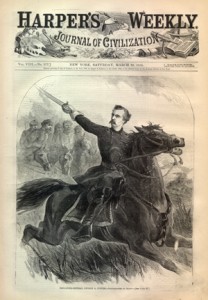
During my recent lecture on the “Era of Expansion,” I remarked that c. 1850 West Point cadets who graduated at or near the top of their class were given commissions to the Army’s topographical branch while those at or near the bottom (like the fellow you see to the left) were dispatched into the cavalry. A student (and veteran Cavalry First Sergeant) took exception to this. Appropriately skeptical, he decided to double-check my claim; in an excellent display of initiative he went straight to the source by sending off an e-mail to folks at the United States Military Academy.
Dr. Samuel Watson, Professor of Military History at the USMA and author of Peacekeepers and Conquerors: The Army Officer Corps on the American Frontier, 1821-1846 (2013), was kind enough to lend his expert insight on the issue. He’s given me permission to paraphrase his remarks:
“Cavalry” became a branch open to West Point graduates in 1833 when the Battalion of Mounted Rangers (originally formed in 1832 and officered with frontiersmen commissioned directly from civilian life) was reformed in 1833 as the First Dragoon Regiment in the Regular Army. Although, in principle, any cadet could choose cavalry, in practice class rank determined the order in which cadets made their decisions, subject to the limited number of slots available. Until the 1850s, few cadets from the top half (or even 3/4) of their class chose cavalry.
Why?

 Saving...
Saving...